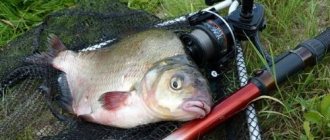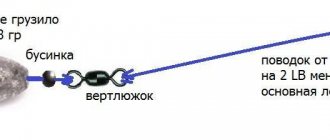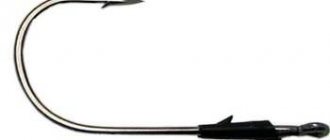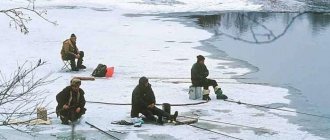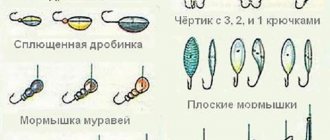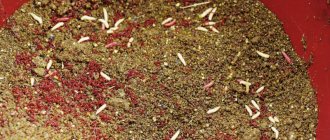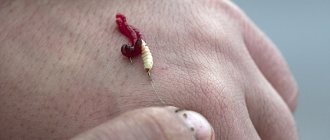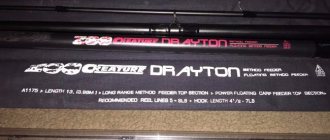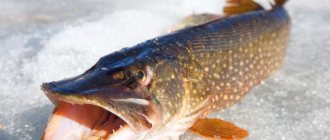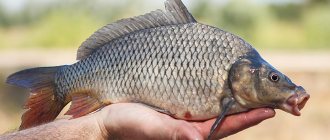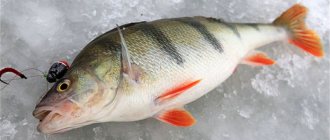Catching carp is always a very exciting activity for every carp angler. In order to maximize the chances of catching such shy and cautious fish, you need to use not only high-quality baits and baits, but also know how to properly install equipment for carp.
This article will discuss in detail what types of rigs there are for carp, how to make them correctly, what hooks to use and much more.
Carp equipment
All carp rigs can be distinguished by the following criteria:
- According to the type of weight used (regular weight, feeder).
- According to the type of installation (blind, sliding).
- According to the type of bait holding (floating, sinking).
- According to the position of the leash.
The type of equipment should be used depending on the fishing conditions.
Nodes
Typically, equipment for catching carp includes the following components:
- braided fishing line;
- monofilament
In order for such fishing lines to hold all the gear well, it is necessary to use the strongest possible knot.
Based on the required purposes, the following components can be used for equipment:
- Making a loop. A paired knot and a surgical loop are used.
- Knot for attaching hooks and boilies. To make it, you need to tie a loop at the end of the leash, and then tie a so-called knotless knot on the hook.
- Knots for attaching leashes to the main line. For such purposes, you need to use the “Palomar”, “Grinner” or “Clinch” knots.
- For fastening monofilaments, Albright type knots are used.
- To attach monofilament to a shock dealer, knots such as “Carrot”, “Grinner” and “Uni” are used.
Hooks
The main requirements that hooks must meet are to be very strong and sharp. They should easily enter the carp lip and hold the fish tightly, while preventing breakdowns.
When purchasing a hook, a fisherman must know exactly what kind of fish he will use it on, and depending on this, choose the size and type of hook.
According to their shape and bend, hooks are:
- The eye of the hook “looks” towards the inside. Such hooks can be used for almost all carp rigs. The sting in such hooks is wrapped towards the eye, while it easily unfolds in the carp’s mouth and deftly hooks the fish, preventing it from dodging. Hooks of these shapes always have a very long, straight shank.
- The eye of the hook “looks” outward. Such hooks are used together with rigid leashes.
- Hooks with a straight eye are used to catch carp fish in the uppermost water levels. In this case, the hook should be installed on top of the bait so that the fish that swims up from the bottom area cannot see it.
- Hooks with a straight eye and a concave fore-end. Such hooks are used for catching very large carp, since they detect the fish very quickly, preventing it from escaping.
Leashes
For leashes, you can use different types of fishing lines. The length of the leashes can also vary. It depends on the fishing conditions.
According to their variety, leashes are:
- hard;
- compound;
- soft;
- combined.
Rigid fishing line leash
To construct rigid leashes, you should use a mono line with a very large diameter or a special line that is designed for leashes. Rigid leashes are convenient because they prevent the carp from spitting out the hook, so it cannot fall off it.
The main disadvantage of such leashes is that they do not lie “naturally” on the bottom. Such leashes are secured with a loop, which gives them some freedom of movement.
Composite leash made from fishing line
Composite leashes are made from two different lines. The main part of the leash is made of rigid mono or florocarbon fishing line. The additional part of the leash is made of soft braid. Both sections of fishing line are fastened using an Albright knot or a swivel.
Soft leash
Soft leashes are made from soft braided fishing line. They are used when the fish bites well and swallows the bait right on the fly.
Due to the fact that the leash is very soft, the carp does not pay attention to it and is not afraid, but at the same time, such a leash is more susceptible to tangling and overlapping than others.
Combined leash
A combined leash is made from two pieces of soft and hard fishing line. The soft part is located at the hook, and the hard part forms the basis of the entire leash. This manufacturing technique makes it possible to prevent tangling of the fishing line, which often happens with leashes made from soft fishing line.
In addition, it is the soft part of the fishing line that will not scare away the fish as much as the hard one, which is why combined leashes are increasingly gaining popularity.
Requirements for carp hooks
The main requirements for hooks for carp fishing: optimal geometry, sharpness and reliability.
Each hook has the following characteristics:
- Form;
- Size;
- Geometry;
- Resistance to extension and fracture toughness.
Looking at the specialized gear for carp fishing, it becomes clear that if you fish with whatever is at hand, then the chances of ending up with a catch will be less than just small. For example, carp hooks are made taking into account the anatomy of the fish, its behavior, the way it swallows bait, the way it resists when fishing and, of course, taking into account the size of the potential prey.
Hook shape and barb design
One of the main parameters is shape. The main differences here are in the design of the sting, barb, shank and eye of the hook. The choice of one design or another is individual, although listening to the recommendations of professionals has always been useful.
So, according to the shape of the sting, hooks can be: curved inward, curved outward and straight. It is believed that the reverse angle of attack of the sting (curved outward) is less popular, although this can be argued.
The shank geometry also adds variety to the carp hook family. In addition to the classic (straight) hooks, there are models with curved outward (banana-shaped) hooks. Experiments with such hooks show that they turn much easier in water and in the mouth of a fish, which helps to securely secure the prey.
In addition, there is a division of products according to the length of the forearm. Shortened, standard and long legs, as well as straight ones along with straight, inwardly and outwardly curved ears, tend to further “confuse” those who are looking for hooks for targeted carp fishing.
We recommend reading: How to catch an asp using a bombard
Another controversial element is the goatee. In the world of carp fishing, opinions differ about the effectiveness of certain barbs. Some advocate wide and clearly defined protrusions, while others, on the contrary, are ready to take a file and grind off the beard or leave it minimal.
Traditionally, questions arise about the numbers on hook packages. If they were strictly tied to size, everything would be clear, but this is not entirely true.
What does the number mean?
There are at least four main classifications of hooks parallel to each other:
- Russian;
- International (Reddical);
- Japanese;
- Finnish.
This introduces certain difficulties when choosing for carp anglers who rely solely on the number. The domestic system is considered (according to the author of the article) the most understandable. In it, the hook number corresponds to the distance from the tip to the leg. The system covers numbers from 2 to 16. The international classification is a mirror image of the Russian one. That is, the maximum number corresponds to the minimum. So our “two” is number 19 of the foreign system.
Japanese and Finnish numbering is similar to the international one, but the numbers in them have a slight shift. The same 19th international is the 21st Japanese and 22nd Finnish. Thus, the average numbers in all systems are very close. For reference, we note that in all (except the Russian) systems there are exceptions (omission of numbers, values with fractions, etc.), but they are of fundamental importance rather for athletes.
Width and height
This parameter is considered key among carp anglers. In addition to the distance from the tip to the stem, the height helps in finding the optimal size and indirectly determines a reliable bite.
Thus, when catching carp on the top, hooks of minimal height are used, and when “treating” a dish of corn grains, long hooks are a priority. The width of the hook also matters depending on the size of the carp, because specimens weighing 4-5 kg are far from the limit for Russian reservoirs. We conclude that a trophy carp is waiting for someone whose equipment has a sufficient margin of safety.
Fastener type
We have already mentioned this element above. Attaching the hook to the fishing line or braid can be either axially or deviated in one direction or another. We will leave this parameter to experiments or consider it one of the secrets of the most successful fishermen.
Recommended reading: Fishing on a feeder in the fall
Sharpening quality
Carp fish are very careful underwater inhabitants and you can’t count on repeated “attacks” of the bait here. There will be only one bite and the fisherman simply must have time to realize it. Thus, the point of the hook must be perfect, and the hooks themselves are used exclusively new or tested for sharpness.
How often do you check your hooks for sharpness?
Before every fishing trip.
33.33%
About once a season.
33.33%
Why check them? Hook it properly and you will always have a catch.
33.33%
Voted: 3
A carp hook is checked for the degree of sharpening mainly visually or tactilely (by touch). Burrs, chips, and ribbing must be excluded here!
Line Aligner Installation
The installation of this equipment should place the sting and fishing line on the same line, which, when pulled, turns the hook in the carp’s mouth so that it is completely inserted behind the fish’s lip.
If the hook has a short tip, then you should use a plastic heat shrink tube, which will make it longer and make it possible to make a full turn.
Manufacturing
To make this leash, you need to use a small piece of rigid plastic tube, the size of which will be no more than one hundred and fifty millimeters. Its diameter should be slightly larger than the diameter of the hook used.
- At the very tip of the leash, tie a loop, which will be needed to hold the boilie on the leash.
- Tie a knot in the middle of the hook shank.
- Tie two more knots near the eye of the hook and then thread the leader through the eye of the hook.
- Thread the leash into the plastic tube.
- Pull the tube onto the hook so that its tip is flush with the hook's point line.
DIY carp leash
There are several known types of leashes that differ from the material used. When making them, you need to take into account the fishing conditions, the nature of the bottom, the presence or absence of vegetation in the water.
Made from soft woven material
This leash is easy to make, it turns out soft and elastic, and the bait is delicately brought to the carp. The soft braid is practically not felt when biting. But the hair can quickly twist, get tangled during sharp casts, and is not resistant to cuts.
The scope of application of such a leash is limited. It is applicable only if there is a clean and hard bottom, without shell shells, vegetation, snags and stones.
To make it you need:
- take the leader material, tie a long loop on it so that you can hide the knot inside the nozzle;
- cut a piece of braid to the required length;
- place the boilie on the loop and stop;
- fix the nozzle by installing a silicone stopper at the bottom;
- put a silicone tube (3 mm in diameter) on the leash and pass it through the sting;
- adjust the hair length, tie the hook, tie it in a knot, tighten;
- check the leash to see how it clings;
- if it is too tenacious, glue the knot;
- equip the leash with a silicone remover to prevent tangling;
- Attach the leash to the tackle, install it to fix it in the place where the diverter is attached.
Made of woven material with a protective sheath
The material is a soft braided fishing line, placed in a plastic shell to protect the leash from possible breaks (cuts). Using a similar model, fishing is possible in snags, in quarries with stones or gravel at the bottom. To prevent it from deforming, you need to constantly keep it stretched and place it only on rigid leads.
A sheathed braided leash will not get tangled even when casting with force, but it is difficult to manufacture and transport.
To install a braided leash in a shell you need:
- remove the sheath from the leash in an area the size of the hair length, but first measure the attachments, which will need to be installed later when assembling the equipment;
- tie a loop;
- cut the braid to the required length, attach the boilie;
- attach a silicone stopper at the bottom;
- put on the tube, pass it through the sting, then onto the hook;
- adjust hair length;
- tie the hook in a knot, tighten;
- adjust hair length;
- glue the knot if the hooks are too tenacious;
- bend the heat shrink tube, the end of which should be adjacent to the hook tip
- put on the diverter or fix the leash on the hook with a swivel, tie it to the ring to obtain a swivel joint;
- attach to the equipment by tying a loop.
Fluorocarbon
The peculiarity of such models is the use of materials of different hardness. The part of the tackle next to the sinker needs to be made more rigid by using fluorocarbon or icecore. The remaining parts of the leash can be made of softer material. Such leashes are invisible to fish.
The rigidity of the material will not allow twisting and gathering into an accordion when lowering to the bottom, and there will be no overlaps when casting.
But fluorocarbon is not cut-resistant, and this is its significant disadvantage. For installation you need:
- cut off a piece of soft material, tie a loop;
- plant the boilie, stop;
- equip the lower part of the fishing line with a silicone stopper;
- tie a steel ring up to 0.2 mm in diameter to the hair;
- thread the hook into the ring and tighten the knot;
- check the hook for grip on the palm;
- adjust the location of the ring on the hook, glue the knot if necessary;
- tie the soft part of the tackle with fluorocarbon in a knot, glue it, singe the knots with a lighter;
- put on the diverter, make a loop on the other rigid part;
- At the junction of two different materials, for strength and to avoid tangling when casting, glue a piece of soft lead or attach a steel weight to limit the height of the nozzle.
This will make the leash durable. The hair attached to the steel ring will move freely along the shank of the hook. Even when spitting out the bait, if it gets pricked on the hook, the ring will quickly move down and the hook, being free, will pierce the fish’s lip quite deeply.
Mounting on carp “Safe clip”
The use of this type of installation is necessary in cases where the fisherman does not want to deal with gear hooks. Based on this, such installation of equipment is used in reservoirs with snags and a lot of algae.
This installation works as follows: when caught by a weight, a feeder, or a line break, the caught fish, with its resistance, seems to “unfasten” the feeder from the rest of the tackle, while saving the hook and leash.
Manufacturing
To construct such a leash, it is advisable to use leash material and a cone-shaped tube.
- Make a loop for attaching boilies and tie the hook using the so-called knotless method.
- Pull a conical tube into the free end so that the length of the tube moves towards the hook.
- Make a loop on the unoccupied tip of the leash.
- Pull the end of the free fishing line into a special clip with a fastener for the weight.
- Make a loop to attach the swivel to the fishing line.
- Attach a leash to the eye of the swivel.
- Place the clip on the swivel so that the latter “sinks” into the clip by two quarters of its size.
- Place a conical tube on the other tip of the swivel.
- Attach the weight and swivel to the clip and close the clasp.
Drive materials
And finally, the last important element for creating catchy carp equipment is a leader, for the manufacture of which you can use leader materials produced in 3 main varieties: soft braided (without a shell), soft braided (with a shell / braided) and hard (nylon or fluorocarbon). Naturally, without taking into account the “sophisticated” combined manufacturing options (for more sophisticated carp anglers).
Sufficiently hard nylon can work just as well as soft braid, while actually using the same carp rigs. Using soft braided materials (sheathed/braided), you can always “remove” the abrasive/resistant coating, and as a result get a soft section that ensures normal mobility of the nozzle against the background of the remaining (harder) part of the entire leash. I assure you that in some situations this must be done! Since carp can feel both the resistance of a hard leash and the “weight” of the sinker, without having yet fully “sucked in” the bait.
Some anglers pay too little attention to the length of the leader. And this is in vain! Since it is this “characteristic” that greatly influences the “detecting ability” of the entire equipment as a whole.
Too long leads lead to insufficient resistance of the “classic” sinker (weighing 3 ounces), thereby providing the opportunity for the fish to easily get rid of the hook. As soon as they feel the prick of the hook, the carp begin to turn their heads violently, and this leads to the fact that the puncture site of the lip increases significantly, which is why the hook falls out. In turn, a short leader is able to provide direct contact between the hook and the sinker (with virtually instantaneous resistance from its 3-ounce weight). In itself, lengthening the leash will be a rational solution only in cases where carp take the bait very carefully, “checking” its natural mobility in advance. Thus, if your “weak” bites do not transform into confident “locomotives” for a very long time, then you should seriously think about the length of the leash. Be sure to change it and compare the new result with the previous one.
In-depth study and thorough understanding of the BASICS of creating leashes and carp equipment (in general) ultimately lead to the fact that the carp angler begins to BELIEVE in his equipment. And this is one of the main aspects of carp fishing! Personally, in 95% of cases I am quite satisfied with the use of only 3 carp rigs: with a single bottom boilie, with a single Pop-Up and, of course, a “snowman”. All these 3 rigs are knitted from identical materials and work successfully - in fact, according to the same principle.
Simple hair installation
A simple hair rig is the easiest rig to make and is where most inexperienced anglers start practicing.
For the leash in this rig, a soft fishing line is used. The nozzle is not attached to the hook, but to a special short leash, which is located next to the hook.
Manufacturing
- Make a loop at the tip of the leash for attaching and holding the boilie.
- Thread the other end of the leash into the eye of the hook.
- Make seven turns around the shank of the hook and press it to the tip of the leader using a loop.
- Pull the unoccupied tip of the leash back into the eye of the hook and tighten tightly.
- Place heat shrink tubing over the eye of the hook.
- Make a loop at the unoccupied tip of the leash to attach it to the main line.
"In-line"
“In-line” installation is a kind of installation of sliding equipment for carp fishing. In this rig, the feeder or weight slides along the main line, which runs inside the weight.
This greatly increases the sensitivity of the entire gear. It is recommended to use such installation in areas where the chance of snags is minimal.
Manufacturing
For installation you will need a swivel, leadcore, an anti-twist tube and a weight with a hole inside.
- Make a small loop at the tip of the leadcore.
- Attach a swivel to this loop.
- Pass the leadcore loop into the eye of the swivel and pull the swivel through this loop again.
- From the other end of the leadcore, thread an anti-twist tube.
- Place a weight or feeder on this tube.
- Attach the leash and hook to the swivel.
- Attach the main line to the other end of the leadcore.
"Helicopter"
“Helicopter” is a variant of equipment for carp, on which the feeder has a blind installation with the main fishing line. The leash and bait slide along the main line and spin around it (like helicopter blades). It is advisable to use such equipment in reservoirs with high currents.
Manufacturing
- Place a locking ring on the main line.
- Make a leash and attach a swivel to its tip.
- Place the leader through the unoccupied eye of the swivel onto the main line.
- Place the second locking ring on the main line.
- Attach a weight or feeder to the tip of the main line.
- The locking rings with the leash should be twenty centimeters from the weight or feeder.
Basics of maximum stealth of equipment and installations
Since carp is a very shy fish, to catch it you should camouflage the equipment as best as possible under the bottom and algae in reservoirs.
In addition, there are also basic rules for making equipment and installations invisible:
- All components of the equipment must be balanced in relation to the breaking load and the fish. You should not use fishing lines with a large diameter and large swivels if the reservoir does not contain carp fish weighing no more than two kilograms.
- The color of the fishing line, weights and other components of the equipment should be natural shades that will blend in with the water and the environment.
- Since carp is very picky about various odors, the equipment should not be allowed to have unnecessary aromas.
- The equipment should lie softly on the bottom. Protrusions of fishing line or other elements should not be allowed.
Carp fishing techniques and tactics
Carp is unpretentious, can be found anywhere in the reservoir, but is shy. In the absence of ingenuity and experience, it is difficult for beginners to catch this fish.
- boilies or special complementary foods as complementary You should not overeat fish. Throwing complementary foods (no more than 200 g at a time) should be done in one place, with pauses of up to 45 minutes. It is possible to add flavorings or steamed peas.
- When choosing tactics before starting fishing, it is worth taking into account some features of the behavior of the fish, the bottom topography, and the terrain in the area.
Carp are shy and in order to avoid swimming away from the feeding area, you need to keep quiet on the water, and also wear camouflage clothing in combination with the shore and vegetation. The brightness, catchiness and unnaturalness of the colors will be quickly noticed by the carp. - As for fishing techniques , feeder tackle, a cone-shaped rod, is best suited for carp, because The fish's jerks can be quite powerful.
- For bait , steamed peas, boiled potatoes, worms, and bread are suitable. The bait gets caught on the hair. The carp makes confident bites, but tastes them for a long time and sucks them before swallowing the hook.
- To avoid line breaks and fishing rod tip breaks, you need to fish out the fish smoothly and carefully, using a hook or landing net when lifting the carp up.
